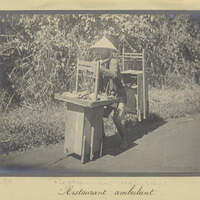[Itinerant Barbers]
Classe
Image fixe
Type
fre
Photographie
Titre
eng
[Itinerant Barbers]
Créateur
Éditeur
fre
Studio de photographie de William Saunders (Shanghai)
Date
1861-1888 ?
Couverture temporelle
1861-1880 ?
Couverture spatiale
Format
fre
JPEG
fre
Recto : 10,2 Mo ; verso : 9,76 Mo
fre
2 vues
Technique et dimensions
fre
Épreuve à l'albumine sur papier montage sur carton
fre
21*26,5 cm
Autre numérotation
fre
24 (numérotation manuscrite de Louis Dumoulin au verso du cliché)
Propriétaire
fre
Photographie acquise par Louis Dumoulin lors de l'un de ses voyages en Extrême-Orient entre 1888 et 1897
Provenance
fre
Bibliothèque de l'ancien Musée des colonies (Paris)
Marque(s) d'appartenance
fre
Tampon bleu au nom de Louis Dumoulin
Source
fre
Université Côte d'Azur. BU Lettres Arts Sciences Humaines. Fonds ASEMI
Cote
PH92-17
Identique à
Droits
fre
Domaine public
Identifiant pérenne
Source(s) utilisée(s)




















Description
Portrait d'un groupe de coiffeurs itinérants au travail. Le Getty possède une autre photographie du même lieu et d'autres barbiers au travail, portant le titre : "No. 24 - Itinerant Barbers". Elle est accompagnée de la légende suivante dont la description peut s'appliquer en partie à notre cliché : "Either of these artists will, for a few cash, shave your head or face, or cleanse your ears, or scrape the inside of your eyelids, finishing up with a shampoo which consists in slapping the back and shoulders with the open hands, and thumping the spine. It is difficult to assign a reason for the desire the Chinese have to get their eyelids scraped. The operation is the cause of a great deal of the ophthalmia so prevalent in the country, and the vast majority of blind people have this also to thank for their helpless condition. In shaving, the Chinese use hot water, but no soap. The water is boiled over a stove carried on one end of a bamboo and balanced by the 'barber's shop' at the other end. The razor is a clumsy piece of soft iron somewhat hatchet-sharped and requiring constant stropping. Anciently the Chinese wore their hair long, and tied into a top-knot. The present fashion is of Tatar origin and was imposed by the reigning dynasty as a mark of servitude.". Dumoulin a acquis ce cliché lors de l'un de ses voyages en Asie entre 1888 et 1897, mais ce tirage est forcément antérieur à 1888 puisque tous les négatifs de Saunders ont brûlé cette année-là.
Annotations
Chine. Personnages (annotation manuscrite de Louis Dumoulin au verso)



